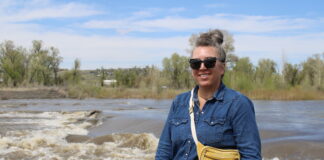
By Jerd Smith
Forty years after the Holy Cross Wilderness Area was created, an early effort to explore tapping its water supplies has generated more than 500 comments to the U.S. Forest Service.
Aurora and Colorado Springs, which own and operate the only reservoir in the area, Homestake I, hope to demonstrate that they can divert more water and build another reservoir to serve Front Range and West Slope interests without damaging the delicate wetlands and streams in the mountain forests there.
But first, they are asking the Forest Service for a special use permit to survey the area and to bore several test holes to determine soil conditions and areas best suited to build the proposed Whitney Reservoir. The public comment period closed June 30, although the Forest Service said it will continue to accept comments.
If a reservoir were to be built, it would also require that the 122,000-acre-plus wilderness area shrink by 500 acres, an action that will require congressional approval.
Significant opposition to the permit request is already building, with the Holy Cross Wilderness Defense Fund threatening legal action to stop the surveying and drilling of test holes into soils, according to comments submitted to the Forest Service.
Also opposing the process, among others, is Colorado state Sen. Kerry Donovan, who represents several West Slope counties. “Our wilderness areas are afforded the highest levels of protection and to begin action that disturbs them today begins a process of destroying them forever,” she said. [Editor’s note: Donovan is on the Board of Trustees of Water Education Colorado, which sponsors Fresh Water News].
In addition, she wrote, “With drought conditions becoming the new normal…it is imperative we protect high altitude water resources and keep each drop in the basin it was born in.”
The Eagle River is a tributary to the drought-stressed Colorado River, whose flows have already begun a serious decline.
Jerry Mallet is president of Colorado Headwaters, an environmental advocacy group. The fight to stop the proposal, he said, “will be as big as the Two Forks fight was several years ago,” referring to the successful effort to stop Two Forks Reservoir from being built on the South Platte River in 1990.
Aurora and Colorado Springs point to their legal obligations to develop a project that serves multiple interests, and which also protects the environment, while ensuring their citizens have access to water in the future.
“The studies…will provide the factual data necessary to identify and evaluate feasible reservoir alternatives to provide critical water supplies for human and environmental purposes,” said Colorado Springs spokesperson Natalie Eckhart. “We recognize the necessity to partner with other agencies throughout this process and are committed to working collaboratively with other communities and agencies to best manage our shared water resources.”
The proposal comes under a 1998 agreement known as the Eagle River Memorandum of Understanding, which allows the reservoir proponents to develop enough water to serve environmental, municipal and industrial interests. Aurora and Colorado Springs hope to develop 33,000 acre-feet of water, an amount roughly equal to that used annually by 66,000 homes.
Under the proposal, Aurora and Colorado Springs would receive 20,000 acre-feet, West Slope interests would receive 10,000 acre-feet, and 3,000 acre-feet would be set aside for the Climax Molybdenum Company.
Parties to the 1998 agreement include Aurora, Colorado Springs, the Colorado River District, the Eagle River Water and Sanitation District, the Upper Eagle River Water and Sanitation District, as well as Vail Associates.
Diane Johnson, spokesperson for the two Eagle River districts, said the agencies haven’t yet taken a position on the proposal, citing the need for the analysis required for the special use permit as well as any actual construction of a reservoir to be completed.
Located west of Vail between Minturn and Leadville, the Holy Cross Wilderness Area was the subject of a significant battle in the 1980s when Aurora and Colorado Springs sought to build a second major reservoir there known as Homestake II.
After opponents successfully took their case all the way to the U.S. Supreme Court, Homestake II was defeated in 1994.
In exchange, however, the cities were granted permission to develop a smaller amount of water in the future in partnership with Western Slope interests, resulting in the project that is now being proposed to the Forest Service.
To submit your comments or to get more information about the survey and drilling proposal, visit this U.S. Forest Service’s web page.
Jerd Smith is editor of Fresh Water News. She can be reached at 720-398-6474, via email at jerd@wateredco.org or @jerd_smith.
Fresh Water News is an independent, nonpartisan news initiative of Water Education Colorado. WEco is funded by multiple donors. Our editorial policy and donor list can be viewed at wateredco.org
This story originally appeared on Fresh Water News on July 8, 2020.
The Water Desk’s mission is to increase the volume, depth and power of journalism connected to Western water issues. We’re an initiative of the Center for Environmental Journalism at the University of Colorado Boulder. The Water Desk launched in April 2019 with support from the Walton Family Foundation. We maintain a strict editorial firewall between our funders and our journalism. The Water Desk is seeking additional funding to build and sustain the initiative. Click here to donate.





